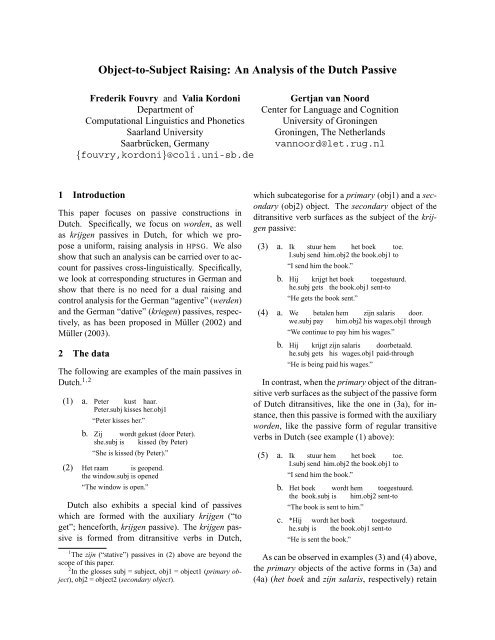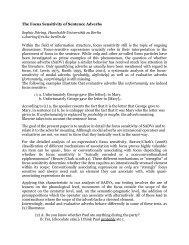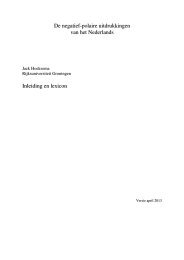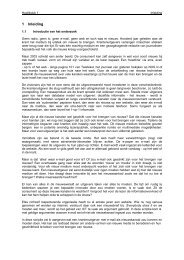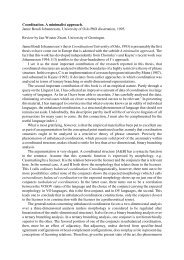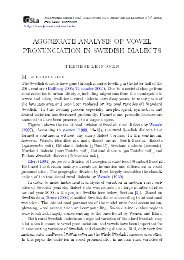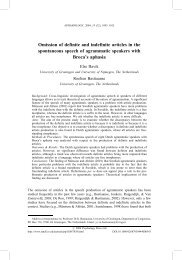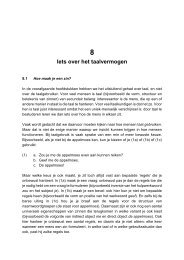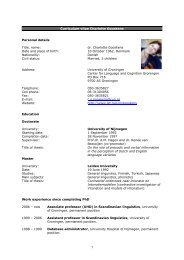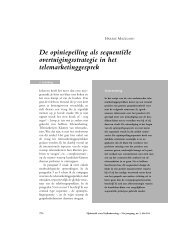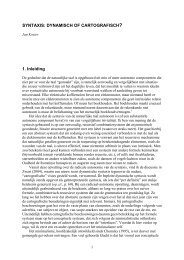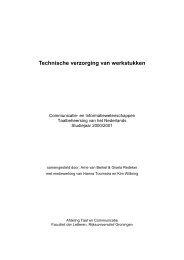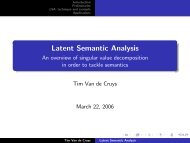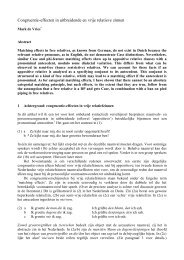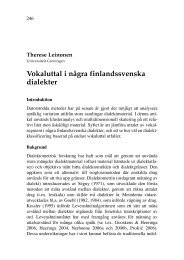Object-to-Subject Raising: An Analysis of the Dutch Passive
Object-to-Subject Raising: An Analysis of the Dutch Passive
Object-to-Subject Raising: An Analysis of the Dutch Passive
You also want an ePaper? Increase the reach of your titles
YUMPU automatically turns print PDFs into web optimized ePapers that Google loves.
<strong>Object</strong>-<strong>to</strong>-<strong>Subject</strong> <strong>Raising</strong>: <strong>An</strong> <strong>An</strong>alysis <strong>of</strong> <strong>the</strong> <strong>Dutch</strong> <strong>Passive</strong><br />
Frederik Fouvry and Valia Kordoni<br />
Department <strong>of</strong><br />
Computational Linguistics and Phonetics<br />
Saarland University<br />
Saarbrücken, Germany<br />
{fouvry,kordoni}@coli.uni-sb.de<br />
Gertjan van Noord<br />
Center for Language and Cognition<br />
University <strong>of</strong> Groningen<br />
Groningen, The Ne<strong>the</strong>rlands<br />
vannoord@let.rug.nl<br />
1 Introduction<br />
This paper focuses on passive constructions in<br />
<strong>Dutch</strong>. Specifically, we focus on worden, as well<br />
as krijgen passives in <strong>Dutch</strong>, for which we propose<br />
a uniform, raising analysis in HPSG. We also<br />
show that such an analysis can be carried over <strong>to</strong> account<br />
for passives cross-linguistically. Specifically,<br />
we look at corresponding structures in German and<br />
show that <strong>the</strong>re is no need for a dual raising and<br />
control analysis for <strong>the</strong> German “agentive” (werden)<br />
and <strong>the</strong> German “dative” (kriegen) passives, respectively,<br />
as has been proposed in Müller (2002) and<br />
Müller (2003).<br />
2 The data<br />
The following are examples <strong>of</strong> <strong>the</strong> main passives in<br />
<strong>Dutch</strong>. 1,2<br />
(1) a. Peter kust haar.<br />
Peter.subj kisses her.obj1<br />
“Peter kisses her.”<br />
b. Zij wordt gekust (door Peter).<br />
she.subj is kissed (by Peter)<br />
“She is kissed (by Peter).”<br />
(2) Het raam is geopend.<br />
<strong>the</strong> window.subj is opened<br />
“The window is open.”<br />
<strong>Dutch</strong> also exhibits a special kind <strong>of</strong> passives<br />
which are formed with <strong>the</strong> auxiliary krijgen (“<strong>to</strong><br />
get”; henceforth, krijgen passive). The krijgen passive<br />
is formed from ditransitive verbs in <strong>Dutch</strong>,<br />
1 The zijn (“stative”) passives in (2) above are beyond <strong>the</strong><br />
scope <strong>of</strong> this paper.<br />
2 In <strong>the</strong> glosses subj = subject, obj1 = object1 (primary object),<br />
obj2 = object2 (secondary object).<br />
which subcategorise for a primary (obj1) and a secondary<br />
(obj2) object. The secondary object <strong>of</strong> <strong>the</strong><br />
ditransitive verb surfaces as <strong>the</strong> subject <strong>of</strong> <strong>the</strong> krijgen<br />
passive:<br />
(3) a. Ik stuur hem het boek <strong>to</strong>e.<br />
I.subj send him.obj2 <strong>the</strong> book.obj1 <strong>to</strong><br />
“I send him <strong>the</strong> book.”<br />
b. Hij krijgt het boek <strong>to</strong>egestuurd.<br />
he.subj gets <strong>the</strong> book.obj1 sent-<strong>to</strong><br />
“He gets <strong>the</strong> book sent.”<br />
(4) a. We betalen hem zijn salaris door.<br />
we.subj pay him.obj2 his wages.obj1 through<br />
“We continue <strong>to</strong> pay him his wages.”<br />
b. Hij krijgt zijn salaris doorbetaald.<br />
he.subj gets his wages.obj1 paid-through<br />
“He is being paid his wages.”<br />
In contrast, when <strong>the</strong> primary object <strong>of</strong> <strong>the</strong> ditransitive<br />
verb surfaces as <strong>the</strong> subject <strong>of</strong> <strong>the</strong> passive form<br />
<strong>of</strong> <strong>Dutch</strong> ditransitives, like <strong>the</strong> one in (3a), for instance,<br />
<strong>the</strong>n this passive is formed with <strong>the</strong> auxiliary<br />
worden, like <strong>the</strong> passive form <strong>of</strong> regular transitive<br />
verbs in <strong>Dutch</strong> (see example (1) above):<br />
(5) a. Ik stuur hem het boek <strong>to</strong>e.<br />
I.subj send him.obj2 <strong>the</strong> book.obj1 <strong>to</strong><br />
“I send him <strong>the</strong> book.”<br />
b. Het boek<br />
<strong>the</strong> book.subj<br />
“The book is sent <strong>to</strong> him.”<br />
wordt hem <strong>to</strong>egestuurd.<br />
is him.obj2 sent-<strong>to</strong><br />
c. *Hij wordt het boek <strong>to</strong>egestuurd.<br />
he.subj is <strong>the</strong> book.obj1 sent-<strong>to</strong><br />
“He is sent <strong>the</strong> book.”<br />
As can be observed in examples (3) and (4) above,<br />
<strong>the</strong> primary objects <strong>of</strong> <strong>the</strong> active forms in (3a) and<br />
(4a) (het boek and zijn salaris, respectively) retain
<strong>the</strong>ir grammatical function (obj1) in <strong>the</strong> passive sentences<br />
in (3b) and (4b). Actually, <strong>the</strong> absence <strong>of</strong> <strong>the</strong><br />
primary object <strong>of</strong> <strong>the</strong> ditransitive active form from<br />
<strong>the</strong> corresponding krijgen passive renders <strong>the</strong> latter<br />
ungrammatical:<br />
(6) *Hij krijgt <strong>to</strong>egestuurd.<br />
he.subj gets sent-<strong>to</strong><br />
“*He was sent.”<br />
2.1 Some interesting exceptions<br />
The only exception in <strong>the</strong> passive patterns in <strong>Dutch</strong><br />
presented in section 2 is observed with <strong>the</strong> verb betalen<br />
(<strong>to</strong> pay) and its derivatives (doorbetalen (<strong>to</strong><br />
continue payment), uitbetalen (<strong>to</strong> pay out), terugbetalen<br />
(<strong>to</strong> pay back), etc).<br />
As shown from examples (5a)–(5c) above, in general<br />
secondary objects (obj2s) in <strong>Dutch</strong> ditransitives<br />
can never passivise with <strong>the</strong> auxiliary worden. That<br />
is, <strong>the</strong> secondary object <strong>of</strong> <strong>Dutch</strong> ditransitives, like<br />
geven and betalen, can never surface as <strong>the</strong> subject<br />
<strong>of</strong> a worden passive:<br />
(7) *Hij wordt het boek gegeven.<br />
he.subj is <strong>the</strong> book.obj1 given<br />
“He is given <strong>the</strong> book.”<br />
(8) *Hij wordt zijn salaris doorbetaald.<br />
he.subj is his wages.obj1 paid-through<br />
“He is being paid his wages.”<br />
<strong>An</strong> exception <strong>to</strong> this pattern is observed in structures<br />
like <strong>the</strong> one in example (9) below. Moreover,<br />
when in active sentences headed by <strong>the</strong> verb betalen<br />
(<strong>to</strong> pay) <strong>the</strong> primary object (obj1) is not phonologically<br />
realised, <strong>the</strong>n krijgen passive structures are<br />
also possible (see example (9b) below), in contrast<br />
<strong>to</strong> <strong>the</strong> behaviour <strong>of</strong> <strong>the</strong> rest <strong>of</strong> <strong>the</strong> <strong>Dutch</strong> ditransitives<br />
as presented in (6) in <strong>the</strong> previous section. This last<br />
pattern is also <strong>to</strong> be observed with <strong>the</strong> verb uitkeren<br />
(<strong>to</strong> pay out benefits; see example (10)).<br />
(9) a. Hij wordt doorbetaald.<br />
he.subj is paid-through<br />
“He is being paid.”<br />
b. Hij krijgt doorbetaald.<br />
he.subj gets paid-through<br />
“He is getting paid.”<br />
(10) a. Hij krijgt uitgekeerd.<br />
he.subj gets paid-out<br />
“He is getting paid out benefits.”<br />
b. Hij wordt uitgekeerd.<br />
he.subj is paid-out<br />
“He is being paid out benefits.”<br />
But whereas (9a) and (9b) have <strong>the</strong> same meaning,<br />
(10b) does not entail <strong>the</strong> same as <strong>the</strong> sentence<br />
in (10a). Specifically, hij is <strong>the</strong> secondary object in<br />
(9a), (9b) and (10a), whereas it is <strong>the</strong> primary object<br />
in (10b). We will return <strong>to</strong> examples (9)–(10) in<br />
section 5.<br />
3 Cross-linguistic evidence and previous<br />
analyses<br />
German also exhibits similar passive structures <strong>to</strong><br />
<strong>the</strong> <strong>Dutch</strong> ones we have presented in section 2. Interesting<br />
for our purposes here are <strong>the</strong> passives <strong>of</strong><br />
German ditransitives shown in <strong>the</strong> following examples<br />
(from Müller (2003)):<br />
(11) a. Der Mann hat den Ball dem Jungen<br />
<strong>the</strong> man.Nom has <strong>the</strong> ball.Acc <strong>the</strong> boy.Dat<br />
geschenkt.<br />
given<br />
“The man gave <strong>the</strong> ball <strong>to</strong> <strong>the</strong> boy.”<br />
b. Der Ball wurde dem Jungen geschenkt.<br />
<strong>the</strong> ball.Nom was <strong>the</strong> boy.Dat given<br />
“The ball was given <strong>to</strong> <strong>the</strong> boy.”<br />
c. Der Junge bekam/kriegte den Ball<br />
<strong>the</strong> boy.Nom got <strong>the</strong> ball.Acc<br />
geschenkt.<br />
given<br />
“The boy got <strong>the</strong> ball as a present.”<br />
Müller (2002), adapting Heinz and Matiasek’s<br />
(1994) account <strong>of</strong>, among o<strong>the</strong>rs, passivisation in<br />
German, proposes a raising analysis for <strong>the</strong> German<br />
werden passives (see example (11b) above)<br />
and a control-like analysis for <strong>the</strong> German bekommen/kriegen<br />
passives, like <strong>the</strong> one in example (11c)<br />
above. The lexical entry for <strong>the</strong> auxiliary bekommen<br />
in (12) below is (slightly modified) from Müller<br />
(2002, p. 149) and captures <strong>the</strong> gist <strong>of</strong> his analysis<br />
for <strong>the</strong> dative bekommen/kriegen passives in German.<br />
(12) bekomm- (dative passive auxiliary)
⎡ 〈<br />
SUBCAT 1 NP [ str ] 〉<br />
⎤<br />
2 ⊕ 3 ⊕ 4<br />
⎡<br />
⎤<br />
ppp<br />
〈<br />
LEX +<br />
〉<br />
〈<br />
XCOMP V<br />
[ ] 〉<br />
⎢<br />
⎢SUBCAT<br />
3 ⊕ NP ldat 2 ⊕ 4<br />
⎥<br />
⎣<br />
⎣<br />
⎦ ⎥<br />
⎦<br />
XCOMP 〈〉<br />
The control-like part <strong>of</strong> <strong>the</strong> account he proposes<br />
lies on <strong>the</strong> subject <strong>of</strong> <strong>the</strong> dative passive auxiliary being<br />
coindexed with <strong>the</strong> dative element <strong>of</strong> <strong>the</strong> embedded<br />
participle. As mentioned in Müller (2002,<br />
p. 149) “all elements from <strong>the</strong> SUBCAT list <strong>of</strong> <strong>the</strong><br />
embedded verb are raised <strong>to</strong> <strong>the</strong> SUBCAT list <strong>of</strong><br />
bekommen except for <strong>the</strong> dative object”.<br />
The analysis in (12) above for <strong>the</strong> German bekommen/kriegen<br />
passives is somewhat surprising given<br />
<strong>the</strong> fact that passive structures in German headed by<br />
bekommen/kriegen do not entail that somebody gets<br />
something, as <strong>the</strong> following examples from Müller<br />
(2002, p. 132) also aim at showing:<br />
(13) Er bekam zwei Zähne ausgeschlagen.<br />
he got two teeth PART(out).knocked<br />
“He got two teeth knocked out.”<br />
(14) a. Der Bub bekommt/kriegt das Spielzeug<br />
<strong>the</strong> lad gets<br />
<strong>the</strong> <strong>to</strong>y<br />
weggenommen.<br />
PART(away).taken<br />
“The boy has <strong>the</strong> <strong>to</strong>y taken away from him.”<br />
b. Der Betrunkene bekam/kriegte<br />
<strong>the</strong> drunk got<br />
die Fahrerlaubnis entzogen.<br />
<strong>the</strong> driving allowance withdrawn<br />
“The drunk had his driving license taken away.”<br />
As Müller (2002, p. 132) also proposes “<strong>the</strong><br />
meaning <strong>of</strong> bekommen and kriegen is bleached in<br />
<strong>the</strong>se constructions. Therefore it is not justified<br />
<strong>to</strong> assume that <strong>the</strong> subject in such dative passive<br />
constructions is a receiver and gets a <strong>the</strong>matic role<br />
from bekommen/erhalten/kriegen”. In o<strong>the</strong>r words,<br />
Müller (2002) also disfavours a control analysis for<br />
<strong>the</strong> German bekommen/kriegen “dative” passives.<br />
The only reason imposing an analysis like <strong>the</strong> one<br />
presented in (12) we can think <strong>of</strong> is <strong>the</strong> realistic technical<br />
difficulty <strong>to</strong> have <strong>the</strong> lexically case marked dative<br />
secondary object (NP [ ldat]<br />
) <strong>of</strong> <strong>the</strong> SUBCAT list<br />
<strong>of</strong> <strong>the</strong> passive participle getting raised <strong>to</strong> <strong>the</strong> subject<br />
NP <strong>of</strong> <strong>the</strong> auxiliary bekommen/kriegen, which<br />
should bear a structural nominative case. Thus, <strong>the</strong><br />
analysis in (12) only denotes an index sharing between<br />
<strong>the</strong> structurally case marked subject NP <strong>of</strong> <strong>the</strong><br />
auxiliary bekommen/kriegen and <strong>the</strong> lexically case<br />
marked secondary object NP <strong>of</strong> <strong>the</strong> passive participle,<br />
in <strong>the</strong> spirit <strong>of</strong> a control analysis, instead <strong>of</strong><br />
an entire synsem object sharing between <strong>the</strong>se two<br />
NPs, which would have been expected under a raising<br />
analysis, as would have also, apparently, been<br />
favoured by Müller (2002).<br />
4 Motivation for a raising analysis <strong>of</strong><br />
passives in <strong>Dutch</strong><br />
The analysis we propose and formalise in <strong>the</strong> next<br />
section for <strong>the</strong> <strong>Dutch</strong> passives we have presented in<br />
section 2 is a uniform raising analysis. The motivation<br />
in favour <strong>of</strong> such an analysis, especially for <strong>the</strong><br />
krijgen passives, in contrast <strong>to</strong> a control analysis like<br />
<strong>the</strong> one proposed in (12) in section 3, is based on <strong>the</strong><br />
general treatment <strong>of</strong> raising and control phenomena<br />
presented in Pollard and Sag (1994).<br />
Specifically, following Jacobson (1990), Pollard<br />
and Sag (1994, p. 141) show that whereas equi verbs<br />
allow NPs (or PPs) instead <strong>of</strong> <strong>the</strong>ir VP complement,<br />
this is never true for raising verbs (<strong>the</strong> examples are<br />
from Pollard and Sag (1994, pp. 141–142)):<br />
(15) Leslie tried/attempted/wants something/it/<strong>to</strong> win.<br />
(16) *Whitney seems/happens something/it.<br />
Such contrasts between equi and raising verbs,<br />
Pollard and Sag (1994, p. 142) comment,“follow directly<br />
from <strong>the</strong> <strong>Raising</strong> Principle. 3 Since <strong>the</strong> raising<br />
verbs in (16) assign no semantic role <strong>to</strong> <strong>the</strong>ir subject<br />
argument, <strong>the</strong>re must be an unsaturated complement<br />
on <strong>the</strong> same SUBCAT list. But NPs like something or<br />
it are saturated, and hence <strong>the</strong> SUBCAT list required<br />
for examples like those in (16) is systematically excluded.”<br />
krijgen-headed structures in <strong>Dutch</strong> behave in a<br />
similar way <strong>to</strong> raising structures like <strong>the</strong> one in example<br />
(16) above:<br />
3 <strong>Raising</strong> Principle (Pollard and Sag, 1994, p. 140): Let E<br />
be a lexical entry whose SUBCAT list L contains an element X<br />
not specified as expletive. Then X is lexically assigned no semantic<br />
role in <strong>the</strong> [ content <strong>of</strong> E if and only if L also contains a<br />
〈<br />
(nonsubject) Y SUBCAT X〉 ] .
(17) ?Hij krijgt het boek <strong>to</strong>egestuurd en zijn buurman<br />
he gets <strong>the</strong> book sent and his neighbour<br />
krijgt dat ook.<br />
gets that <strong>to</strong>o<br />
(18) *Hij<br />
he<br />
“*He is sent <strong>the</strong> book and his neighbour is that <strong>to</strong>o.”<br />
krijgt uitbetaald en Piet krijgt dat ook.<br />
gets paid and Peter gets that <strong>to</strong>o<br />
“*He gets paid and Peter gets that <strong>to</strong>o.”<br />
krijgen does not introduce a semantic role (like<br />
<strong>the</strong> auxiliaries worden (passive) and hebben (perfect<br />
tenses)).<br />
5 Formalisation <strong>of</strong> <strong>the</strong> analysis<br />
Based on <strong>the</strong> motivation presented in section 4, we<br />
formalise our analysis for <strong>the</strong> <strong>Dutch</strong> worden passive<br />
in <strong>the</strong> lexical entry in (19) below and our analysis<br />
for <strong>the</strong> <strong>Dutch</strong> krijgen passive in <strong>the</strong> lexical entry in<br />
(20) below. Both lexical entries use <strong>the</strong> function<br />
raise <strong>to</strong> nominative() (Figure 1). 4<br />
This function takes a noun synsem, and preserves<br />
all values in <strong>the</strong> output, except for <strong>the</strong> CASE value,<br />
which is set <strong>to</strong> nominative.<br />
As aimed at and expected, in both lexical entries<br />
below all <strong>the</strong> elements <strong>of</strong> <strong>the</strong> SUBCAT list <strong>of</strong> <strong>the</strong> embedded<br />
participle are raised <strong>to</strong> <strong>the</strong> SUBCAT list <strong>of</strong><br />
worden and krijgen, respectively. In <strong>the</strong> case <strong>of</strong> worden,<br />
<strong>the</strong> accusative primary object <strong>of</strong> <strong>the</strong> embedded<br />
participle surfaces as <strong>the</strong> nominative subject <strong>of</strong> <strong>the</strong><br />
auxiliary after raising. In <strong>the</strong> case <strong>of</strong> krijgen, it is <strong>the</strong><br />
dative secondary object which surfaces as <strong>the</strong> nominative<br />
subject <strong>of</strong> <strong>the</strong> auxiliary after raising. 5<br />
(19) worden (passive auxiliary)<br />
⎡<br />
SUBCAT<br />
XCOMP<br />
⎢<br />
⎣<br />
〈<br />
( ) 〉<br />
raise <strong>to</strong> nominative 1 ⊕ 2 ⊕ 3<br />
⎡<br />
ppp<br />
〈<br />
LEX V<br />
⎢SUBCAT<br />
⎣<br />
+<br />
XCOMP 〈〉<br />
〈<br />
2 ⊕<br />
[<br />
1 NP<br />
(20) krijgen (dative passive auxiliary)<br />
⎤<br />
⎤<br />
CASE acc] 〉 〉<br />
⊕ 3<br />
⎥<br />
⎦ ⎥<br />
⎦<br />
4 There are o<strong>the</strong>r ways in which <strong>the</strong> same effect can be<br />
obtained in a formalism. We chose a function because it is<br />
compact and easy <strong>to</strong> understand. Specifically, <strong>the</strong> function<br />
raise <strong>to</strong> nominative() (Figure 1) is really only an abbrevia<strong>to</strong>ry<br />
device, since it only consists <strong>of</strong> simple unifications. The same<br />
effect could be obtained, more verbosely, without functions.<br />
5 In our analysis, primary objects (obj1) bear accusative case,<br />
and secondary objects (obj2) dative case.<br />
⎡<br />
SUBCAT<br />
XCOMP<br />
⎢<br />
⎣<br />
〈<br />
( ) 〉<br />
raise <strong>to</strong> nominative 1 ⊕ 2 ⊕ 3<br />
⎡<br />
ppp<br />
〈<br />
LEX V<br />
⎢SUBCAT<br />
⎣<br />
+<br />
XCOMP 〈〉<br />
〈<br />
2 ⊕<br />
[<br />
1 NP<br />
⎤<br />
⎤<br />
CASE dat] 〉 〉<br />
⊕ 3<br />
⎥<br />
⎦ ⎥<br />
⎦<br />
The lexical entry in (19) accounts for <strong>the</strong> examples<br />
in (1b) and (5b) in section 2. In <strong>the</strong> case <strong>of</strong><br />
example (1b) <strong>the</strong> value <strong>of</strong> 2 in (19) is <strong>the</strong> empty list,<br />
since <strong>the</strong> verb kussen (<strong>to</strong> kiss) is transitive, and not<br />
ditransitive. 3 may contain PP denoting <strong>the</strong> logical<br />
subject (door Peter in example (1b)).<br />
The lexical entry in (20) accounts for <strong>the</strong> examples<br />
in (3b) and (4b) in section 2, where <strong>the</strong> ditransitive<br />
verbs have a primary object. For most ditransitive<br />
verbs, <strong>the</strong> primary object is compulsory, while<br />
for uitkeren and <strong>the</strong> betalen-family, it is optional.<br />
Example (6) demonstrates <strong>the</strong> former: <strong>the</strong> primary<br />
object is missing, while in (3b) and (4b) it is present<br />
(i.e. 2 in (20) is a list containing <strong>the</strong> primary object).<br />
In examples (9b) and (10a) on <strong>the</strong> o<strong>the</strong>r hand, 2 is<br />
<strong>the</strong> empty list: <strong>the</strong> primary object is absent.<br />
This variation is a lexical property <strong>of</strong> <strong>the</strong> verbs,<br />
and not limited <strong>to</strong> <strong>the</strong> passive mood, as <strong>the</strong> following<br />
examples show.<br />
(21) *Ik stuur hem <strong>to</strong>e.<br />
I.subj send him.obj2 <strong>to</strong><br />
“*I send him.”<br />
(22) We betalen hem door.<br />
We.subj pay him.obj2 through<br />
“We continue <strong>to</strong> pay him.”<br />
(23) Ze keren het uit.<br />
<strong>the</strong>y.subj pay it. out<br />
“They pay it out benefits.”<br />
(21) is (3) without (compulsory) primary object,<br />
(22) (4a) without (optional) primary object, and (23)<br />
(10) also without (optional) primary object.<br />
As far as example (9) is concerned, we assume<br />
that <strong>the</strong> verb betalen (<strong>to</strong> pay), as well as its derivatives<br />
doorbetalen, uitbetalen, terugbetalen, etc.,<br />
may also have a purely transitive use:<br />
(24) a. Ik betaal de tuinman.<br />
I.subj pay <strong>the</strong> gardener.obj1<br />
b. De tuinman wordt betaald.<br />
<strong>the</strong> gardener.subj is paid
⎛<br />
raise <strong>to</strong> nominative<br />
⎜<br />
⎝<br />
⎡<br />
LOC<br />
⎢<br />
⎣<br />
NONLOC 5<br />
⎡<br />
⎡ [<br />
HEAD CASE<br />
CAT ⎢<br />
⎣SUBCAT 1<br />
LEX 2<br />
⎢<br />
⎣CONTENT 3<br />
CONTEXT 4<br />
]<br />
⎤<br />
case<br />
⎦<br />
⎦<br />
⎥<br />
⎦<br />
⎞<br />
−→<br />
⎟<br />
⎠<br />
⎡<br />
LOC<br />
⎢<br />
⎣<br />
NONLOC 5<br />
⎡<br />
⎡ [<br />
HEAD CASE<br />
CAT<br />
⎢SUBCAT 1<br />
⎣<br />
LEX 2<br />
⎢<br />
⎣<br />
CONTENT 3<br />
CONTEXT 4<br />
]<br />
⎤<br />
nom<br />
⎦<br />
⎦<br />
⎥<br />
⎦<br />
Figure 1: Definition <strong>of</strong> <strong>the</strong> function raise <strong>to</strong> nominative()<br />
In such cases, <strong>the</strong> sole object <strong>of</strong> <strong>the</strong> active form <strong>of</strong><br />
<strong>the</strong> betalen-family verbs is considered <strong>to</strong> be <strong>the</strong>ir primary<br />
object, which may, <strong>the</strong>refore, be accounted for<br />
by <strong>the</strong> auxiliary worden in (19). Then <strong>the</strong> value <strong>of</strong><br />
2 in (19) is <strong>the</strong> empty list, since <strong>the</strong> verb betalen (<strong>to</strong><br />
pay) is considered <strong>to</strong> function as transitive, and not<br />
ditransitive.<br />
6 Conclusion<br />
We have motivated and formalised a uniform raising<br />
analysis for <strong>the</strong> worden and krijgen passives in<br />
<strong>Dutch</strong>. The analysis accounts for <strong>the</strong> <strong>Dutch</strong> data presented<br />
in section 2, without needing <strong>to</strong> find refuge<br />
<strong>to</strong> ad hoc <strong>the</strong>oretical and technical resorts, like <strong>the</strong><br />
analysis <strong>of</strong> Müller (2002) (cf., <strong>the</strong> control-like analysis<br />
<strong>of</strong> <strong>the</strong> German bekommen/kriegen passives), as<br />
presented in section 3. The formalisation <strong>of</strong> <strong>the</strong> analysis<br />
in section 5 is essentially based on <strong>the</strong> fact that<br />
<strong>the</strong> information shared in raising constructions may<br />
leave out some paths from <strong>the</strong> SYNSEM information,<br />
while still remaining a raising analysis. In <strong>the</strong> case<br />
at hand, <strong>the</strong> SYNSEM value <strong>of</strong> <strong>the</strong> primary object <strong>of</strong><br />
<strong>the</strong> embedded participle <strong>of</strong> <strong>the</strong> worden passive, as<br />
well <strong>the</strong> SYNSEM value <strong>of</strong> <strong>the</strong> secondary object <strong>of</strong><br />
<strong>the</strong> embedded participle <strong>of</strong> <strong>the</strong> krijgen passive, are<br />
raised <strong>to</strong> <strong>the</strong> subject <strong>of</strong> <strong>the</strong>ir respective auxiliaries,<br />
with only <strong>the</strong>ir CASE value changing <strong>to</strong> <strong>the</strong> nominative<br />
case required by <strong>the</strong> subject. Such a formalisation<br />
does not only account in a straightforward<br />
way for <strong>the</strong> behaviour <strong>of</strong> <strong>the</strong> <strong>Dutch</strong> data at hand (see<br />
section 2), but it can also <strong>of</strong>fer a solution <strong>to</strong> <strong>the</strong> analysis<br />
presented in (12) in section 3 for <strong>the</strong> German<br />
bekommen/kriegen passives. Finally, such a formalisation<br />
also amends naturally <strong>the</strong> shortcomings <strong>of</strong> <strong>the</strong><br />
intended raising analyses <strong>of</strong> German passives proposed<br />
in Kathol (1994) and Pollard (1994), which<br />
suggest that what should be raised <strong>to</strong> <strong>the</strong> subject <strong>of</strong><br />
<strong>the</strong> werden and bekommen/kriegen passives is not<br />
<strong>the</strong> entire argument NP, but only its INDEX specification,<br />
since indices do not contain a specification<br />
for CASE, and <strong>the</strong>y can, thus, belong <strong>to</strong> NPs with<br />
different case values without giving rise <strong>to</strong> a conflict.<br />
But as also mentioned in section 3, structuresharing<br />
only among indices points <strong>to</strong> a control analysis<br />
<strong>of</strong> passivisation in German, and not only. Thus,<br />
our analysis, which formally captures <strong>the</strong> fact that<br />
passivisation is based on structure-sharing <strong>of</strong> entire<br />
synsem objects, is <strong>the</strong> most straightforward analysis.<br />
References<br />
Wolfgang Heinz and Johannes Matiasek. 1994. Argument<br />
structure and case assignment in German. In<br />
John Nerbonne, Klaus Netter, and Carl Pollard, edi<strong>to</strong>rs,<br />
German in Head-Driven Phrase Structure Grammar,<br />
pages 199–236. CSLI Publications. No. 46 in<br />
CSLI Lecture Notes.<br />
Pauline Jacobson. 1990. <strong>Raising</strong> as function composition.<br />
Linguistics and Philosophy, 13:423–475.<br />
<strong>An</strong>dreas Kathol. 1994. <strong>Passive</strong>s without Lexical Rules.<br />
In John Nerbonne, Klaus Netter, and Carl Pollard, edi<strong>to</strong>rs,<br />
German in Head-Driven Phrase Structure Grammar,<br />
pages 237–272. CSLI Publications. No. 46 in<br />
CSLI Lecture Notes.<br />
Stefan Müller. 2002. Complex Predicates: Verbal Complexes,<br />
Resultative Constructions, and Particle Verbs<br />
in German. Number 13 in Studies in Constraint-Based<br />
Lexicalism. Center for <strong>the</strong> Study <strong>of</strong> Language and Information,<br />
Stanford.<br />
Stefan Müller. 2003. <strong>Object</strong>-<strong>to</strong>-subject-raising and lexical<br />
rule: <strong>An</strong> analysis <strong>of</strong> <strong>the</strong> German passive. In Stefan<br />
Müller, edi<strong>to</strong>r, Proceedings <strong>of</strong> <strong>the</strong> HPSG-2003 Conference,<br />
Michigan State University, East Lansing, pages<br />
278–297. CSLI Publications.<br />
Carl Pollard and Ivan A. Sag. 1994. Head-Driven Phrase<br />
Structure Grammar. University <strong>of</strong> Chicago Press.<br />
Carl Pollard. 1994. Toward a Unified Account <strong>of</strong> <strong>Passive</strong><br />
in German. In John Nerbonne, Klaus Netter, and<br />
Carl Pollard, edi<strong>to</strong>rs, German in Head-Driven Phrase<br />
Structure Grammar, pages 273–296. CSLI Publications.<br />
No. 46 in CSLI Lecture Notes.


